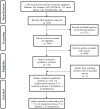Accelerometer measured levels of moderate-to-vigorous intensity physical activity and sedentary time in children and adolescents with chronic disease: A systematic review and meta-analysis
- PMID: 28640907
- PMCID: PMC5480890
- DOI: 10.1371/journal.pone.0179429
Accelerometer measured levels of moderate-to-vigorous intensity physical activity and sedentary time in children and adolescents with chronic disease: A systematic review and meta-analysis
Abstract
Context: Moderate-to-vigorous physical activity (MVPA) and sedentary time (ST) are important for child and adolescent health.
Objective: To examine habitual levels of accelerometer measured MVPA and ST in children and adolescents with chronic disease, and how these levels compare with healthy peers.
Methods: Data sources: An extensive search was carried out in Medline, Cochrane library, EMBASE, SPORTDiscus and CINAHL from 2000-2017. Study selection: Studies with accelerometer-measured MVPA and/or ST (at least 3 days and 6 hours/day to provide estimates of habitual levels) in children 0-19 years of age with chronic diseases but without co-morbidities that would present major impediments to physical activity. In all cases patients were studied while well and clinically stable.
Results: Out of 1592 records, 25 studies were eligible, in four chronic disease categories: cardiovascular disease (7 studies), respiratory disease (7 studies), diabetes (8 studies), and malignancy (3 studies). Patient MVPA was generally below the recommended 60 min/day and ST generally high regardless of the disease condition. Comparison with healthy controls suggested no marked differences in MVPA between controls and patients with cardiovascular disease (1 study, n = 42) and type 1 diabetes (5 studies, n = 400; SMD -0.70, 95% CI -1.89 to 0.48, p = 0.25). In patients with respiratory disease, MVPA was lower in patients than controls (4 studies, n = 470; SMD -0.39, 95% CI -0.80, 0.02, p = 0.06). Meta-analysis indicated significantly lower MVPA in patients with malignancies than in the controls (2 studies, n = 90; SMD -2.2, 95% CI -4.08 to -0.26, p = 0.03). Time spent sedentary was significantly higher in patients in 4/10 studies compared with healthy control groups, significantly lower in 1 study, while 5 studies showed no significant group difference.
Conclusions: MVPA in children/adolescents with chronic disease appear to be well below guideline recommendations, although comparable with activity levels of their healthy peers except for children with malignancies. Tailored and disease appropriate intervention strategies may be needed to increase MVPA and reduce ST in children and adolescents with chronic disease.
Conflict of interest statement
Figures




References
-
- Health, U.D.o. and H. Services, Physical Activity Guidelines for Americans (ODPHP Publication No. U0036). Washington, DC: US Government Printing Office; 2008.
-
- Durstine J.L., Armstrong N., and Cheng S.L., Children's physical activity and health—Chronic disease in children and young adults. Journal of Sport and Health Science, 2013. 2(1): p. 1–2.
-
- Colley, R.C., et al., Physical activity, sedentary behaviour and sleep in Canadian children: parent-report versus direct measures and relative associations with health risk. 2012: Statistics Canada. - PubMed
-
- Byun W., Dowda M., and Pate R.R., Associations between screen-based sedentary behavior and cardiovascular disease risk factors in Korean youth. Journal of Korean medical science, 2012. 27(4): p. 388–394. doi: 10.3346/jkms.2012.27.4.388 - DOI - PMC - PubMed
-
- Twisk J.W., Physical activity guidelines for children and adolescents: a critical review. Sports Med, 2001. 31(8): p. 617–27. - PubMed
Publication types
MeSH terms
LinkOut - more resources
Full Text Sources
Other Literature Sources
Medical

